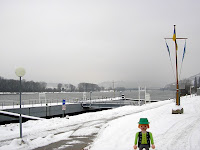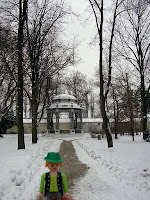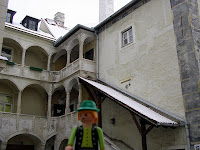
The Danube!
 View over Krems and the vineyards where the famous Wachauer wine holds his winter sleep.
View over Krems and the vineyards where the famous Wachauer wine holds his winter sleep.
EKT said on the right hill, hidden in the fog is the abbey Stift Göttweig, part of the Unesco World Cultural Heritage. Krems University:
Krems University:
The Virginier cigar, produced in what is today the Kunsthalle, was so popular that a new factory was built in 1918 on the premises of today’s campus especially for manufacturing this cigar. The three-story reinforced steel frame structure now housing Danube University Krems was built between 1919 and 1922 according to plans by Paul Hoppe. About 800 workers hand-rolled cigars in the new factory building for several decades. In 1931 the factory output peaked at 75 million cigars. Danube University Krems moved into the newly adapted facility in 1995.
Campus Krems, opened on 7 Oct. 2005, is an optimum complex for about 4,500 students and 400 employees, featuring ultra-modern teaching and research facilities, student apartments, cafés and an arthouse cinema plus a campus train station. The boiler house of the tobacco factory with its striking smokestack was renovated for the Austrian Film Gallery and now houses an arthouse cinema. Donau-University:
Donau-University:
A renovated tobacco factory dating back to the onset of the 20th century and new buildings on Campus Krems provide students and educators room for research and studying. (wikipedia) Main entree Campus Krems, Donau Uni.
Main entree Campus Krems, Donau Uni.
The design for the new buildings is the creation of Architekt Dietmar Feichtinger, who places a new facade of steel, glass and aluminium opposite the industrial building from the previous century. (wikipedia) Erdbeermaus and me in front of the Kunsthalle Krems:
Erdbeermaus and me in front of the Kunsthalle Krems:
Kunsthalle Krems is housed in a former tobacco factory next to the prison on Franz Zeller Platz. It was built by Adalbert Wohlschläger in 1852 and was the first tobacco factory in Stein. In 1994/95, the structure was adapted for use as an exhibition hall according to plans by Adolf Krischanitz, who created 1400 square meters of exhibition space. Across from the Kunsthalle are two life-size figures by Austrian cartoonist Manfred Deix welcoming visitors to the Caricature Museum, planned by Austrian architect Gustav Peichl and opened in 2001. The former carpet factory adjoining the museum to the east today houses the Kunsthalle Krems Factory as well as the Unabhängige Literaturhaus Niederösterreich and the Artothek. The local art mile, Kunstmeile Krems, also offers events and shows at the Film Gallery at Campus Krems and in the former Minorite Monastery in Stein with the Frohner Forum and Museum Stein as well as the Ernst Krenek Documentation (opened in 2008).
Across from the Kunsthalle are two life-size figures by Austrian cartoonist Manfred Deix welcoming visitors to the Caricature Museum, planned by Austrian architect Gustav Peichl and opened in 2001. The former carpet factory adjoining the museum to the east today houses the Kunsthalle Krems Factory as well as the Unabhängige Literaturhaus Niederösterreich and the Artothek. The local art mile, Kunstmeile Krems, also offers events and shows at the Film Gallery at Campus Krems and in the former Minorite Monastery in Stein with the Frohner Forum and Museum Stein as well as the Ernst Krenek Documentation (opened in 2008). Another Deix Statue - and me.
Another Deix Statue - and me.
The well-known jail in Stein, where many dangerous criminals are arrested.

The old part of the prison Stein. Since 1850 it's a jailhouse, but it was built as a monastery.

A beautiful pavillion in the town park.

Dreifaltigkeitssäule

A part of the old townwall of Krems.
 The Steiner Tor is the town landmark of Krems and the only one of the four town gates still preserved. The main tower dating to the late 15th century bears various inscriptions on its outer walls including “AEIOU”, the personal insignia of Emperor Friedrich III (“Alles Erdreich ist Österreich untertan” (English = “All the earth is subordinate to Austria”)). Three crests from 1756 decorate the entrance to the town. To the left is the town crest granted by Emperor Friedrich III and still used today showing the crowned double eagle on a black background; to the right, the crest of Ladislaus Posthumus; in the middle, the crest of Maria Theresa.
The Steiner Tor is the town landmark of Krems and the only one of the four town gates still preserved. The main tower dating to the late 15th century bears various inscriptions on its outer walls including “AEIOU”, the personal insignia of Emperor Friedrich III (“Alles Erdreich ist Österreich untertan” (English = “All the earth is subordinate to Austria”)). Three crests from 1756 decorate the entrance to the town. To the left is the town crest granted by Emperor Friedrich III and still used today showing the crowned double eagle on a black background; to the right, the crest of Ladislaus Posthumus; in the middle, the crest of Maria Theresa.
The area in front of the Steiner Tor was originally subject to Danube flooding. The town walls served as flood protection and were not able to be razed until the 19th century when flood control measures rendered the river less dangerous. A memorial stone inside the Steiner Tor calls to mind the disastrous flood of 1573 when ice flows caused flooding on Landstrasse. Obere Landstrasse, the pedestrian precinct in Krems, begins just beyond the Steiner Tor. Together with the Untere Landstrasse, it has served as the main artery through the historical center of Krems since the Middle Ages and extends for about 700 meters to the Vienna Bridge.
Obere Landstrasse, the pedestrian precinct in Krems, begins just beyond the Steiner Tor. Together with the Untere Landstrasse, it has served as the main artery through the historical center of Krems since the Middle Ages and extends for about 700 meters to the Vienna Bridge. The Gozzoburg dominates the south edge of Hoher Markt, the oldest part of town. Gozzo was a wealthy and respected burgher of Krems and served several terms as town judge. Around 1250, he acquired the land and the preceding building, whose oldest parts dated to the first half of the 13th century, and made extensive structural alterations. The magnificent residence and administrative complex is one of the finest examples of Early Gothic secular architecture in Austria. It is modeled on Italian palaces, with its loggia open to the street and with the large hall above it. The crest hall on the upper story has a beam ceiling dating to 1254 and served as a venue for court proceedings, council meetings and official occasions.
The Gozzoburg dominates the south edge of Hoher Markt, the oldest part of town. Gozzo was a wealthy and respected burgher of Krems and served several terms as town judge. Around 1250, he acquired the land and the preceding building, whose oldest parts dated to the first half of the 13th century, and made extensive structural alterations. The magnificent residence and administrative complex is one of the finest examples of Early Gothic secular architecture in Austria. It is modeled on Italian palaces, with its loggia open to the street and with the large hall above it. The crest hall on the upper story has a beam ceiling dating to 1254 and served as a venue for court proceedings, council meetings and official occasions.
After Gozzo’s death, the complex changed hands and functions several times. A general renovation took place in 2006.Today, visitors are drawn by the Medieval Center in the Gozzoburg, where they can take art history tours through the newly opened complex.
Old building on the "Hoher Markt".

View down the Margarethenstraße, in the back the tower of St. Veit.

The Landstraße, in the background the Steiner Tor.
 Bürgerspitalkirche:
Bürgerspitalkirche:
As in the Steiner Tor, the portal of this church facing Landstrasse bears the inscription “AEIOU” and the construction date 1470 as well as the history of the founding of the church that was part of the adjoining Bürgerspital, a medieval hospice. The roofed hall in Late Gothic style was erected by the burghers of the town with assistance from Emperor Friedrich III. The side of the church facing the street was designed as a decorative façade. Contrary to the usual Gothic practice, the buttresses were incorporated inside instead of projecting outward, where they would have narrowed the Landstrasse, already the main artery through town. Townhall of Krems:
Townhall of Krems:
The structure was bequeathed by the Krems burgess Margarethe von Dachsberg in 1452. It was converted into the town hall about a century later. The Baroque façade has a striking oriel on the southwest corner dating to 1548 and decorated with reliefs. At the bottom is the figure of Samson with the lion. Above that is a base plate with acanthus leaves. Around the base are the crests of the town of Krems and those of Emperors Charles V and Ferdinand I to express the town fathers’ gratitude and loyalty to its rulers. In 1549 a two-bay hall was added to the town hall and can be accessed from the north side, from Pfarrplatz. The wing on the west side of the town hall was built in 1966, at which time the arcades facing Kirchengasse were redone.
Dachsberggasse
 Landstraße
Landstraße Landstraße
Landstraße EKT did not allow me to ride on the camels :(
EKT did not allow me to ride on the camels :(
Täglicher Markt:
The town court was held at Täglicher Markt until 1451, and there was also a public well at this site. Even in the Middle Ages, people faced environmental problems and were concerned about polluted drinking water, so the town was supplied with spring water from the hill above it via systems of wooden pipes.
EKT let me have a ride here

Täglicher Markt No. 2, the Göglhaus, is a large residential complex for burghers with an inside courtyard opening onto Obere Landstrasse and Täglicher Markt. The projecting oriel above the gate to the inner courtyard on the east side has 15th century tracery windows and belonged to an older house chapel dedicated to St. Martin.
 The figurative wall murals were completed in the 16th century and show contemporary scenes from everyday life. For instance, the northern panel shows a group of people in the typical dress of the day gathered around a well. The coats-of-arms depicted below the cornice have been the subject of much research. The latest findings not yet published indicate that they are not fantasy crests as previously thought. A publication will soon reveal their origins, which can be traced precisely.
The figurative wall murals were completed in the 16th century and show contemporary scenes from everyday life. For instance, the northern panel shows a group of people in the typical dress of the day gathered around a well. The coats-of-arms depicted below the cornice have been the subject of much research. The latest findings not yet published indicate that they are not fantasy crests as previously thought. A publication will soon reveal their origins, which can be traced precisely. The Mohrenapotheke at Obere Landstrasse No. 2, an old apothecary, directly abuts the town hall and took on its present form when two older buildings were joined together. The core of this structure also dates to the early 16th century. The sales room has a fresco full of figures that was executed by Martin Johann Schmidt (Kremser Schmidt) around 1756.
The Mohrenapotheke at Obere Landstrasse No. 2, an old apothecary, directly abuts the town hall and took on its present form when two older buildings were joined together. The core of this structure also dates to the early 16th century. The sales room has a fresco full of figures that was executed by Martin Johann Schmidt (Kremser Schmidt) around 1756. The Baroque parish church of St. Veit is about 400 years old in its present form. The bottom section of the tower on the south side bears witness to the predecessor structure from the early 12th century, a Romanesque basilica with a low tower. St. Veit was mentioned as titular saint of the church for the first time in 1178. The parish function was transferred at that time to the new church from St. Stephan am Berg. The building of the new parish church symbolized the victory of the Catholic Church during the Counter Reformation. In 1616 the old church was completely razed except for the tower, and Cypriano Biasino from Milan was commissioned to rebuild it. Construction on the new church progressed rapidly with the help of renowned builders such as Johann Baptist Spazio. Within 15 years they had completed an imposing Early Baroque basilica with eight side chapels and a large transept.
The Baroque parish church of St. Veit is about 400 years old in its present form. The bottom section of the tower on the south side bears witness to the predecessor structure from the early 12th century, a Romanesque basilica with a low tower. St. Veit was mentioned as titular saint of the church for the first time in 1178. The parish function was transferred at that time to the new church from St. Stephan am Berg. The building of the new parish church symbolized the victory of the Catholic Church during the Counter Reformation. In 1616 the old church was completely razed except for the tower, and Cypriano Biasino from Milan was commissioned to rebuild it. Construction on the new church progressed rapidly with the help of renowned builders such as Johann Baptist Spazio. Within 15 years they had completed an imposing Early Baroque basilica with eight side chapels and a large transept. Pfarrplatz
Pfarrplatz The predecessor of this soaring Gothic church, the first in Krems, was first mentioned in 1014 and was outside the town walls at that time. The church dedicated to St. Stephen was largely demolished and newly built in the 16th century. The year 1477 can be seen in the portal of the new nave as an indication of its year of construction. The style of the Late Gothic hall church shows close connections to the Vienna Building Lodge that built St. Stephen’s Cathedral in Vienna and is often referred to as that church’s little sister.
The predecessor of this soaring Gothic church, the first in Krems, was first mentioned in 1014 and was outside the town walls at that time. The church dedicated to St. Stephen was largely demolished and newly built in the 16th century. The year 1477 can be seen in the portal of the new nave as an indication of its year of construction. The style of the Late Gothic hall church shows close connections to the Vienna Building Lodge that built St. Stephen’s Cathedral in Vienna and is often referred to as that church’s little sister.
The watchtower built onto the east side of the structure has been owned by the town since 1616. It housed the town watchman and was inhabited until a few decades ago. Across from the church portal is the Piaristenstiege, a covered stairway leading to Pfarrplatz, which underwent a general renovation in 2004.
The Town Library on the Körnermarkt.

Körnermarkt
 At the bottom of the box was my cuddly place
At the bottom of the box was my cuddly place I want to say hallo to Johannes. It is nice to be back in Stendal.
I want to say hallo to Johannes. It is nice to be back in Stendal. Nice... Thank you EKT!
Nice... Thank you EKT! Here are the souvenirs from Krems and the austrian army.
Here are the souvenirs from Krems and the austrian army. At the bottom of the box was my cuddly place
At the bottom of the box was my cuddly place I want to say hallo to Johannes. It is nice to be back in Stendal.
I want to say hallo to Johannes. It is nice to be back in Stendal. Nice... Thank you EKT!
Nice... Thank you EKT! Here are the souvenirs from Krems and the austrian army.
Here are the souvenirs from Krems and the austrian army. My new friends at the "Hemingway
My new friends at the "Hemingway Erdbeermau
Erdbeermau Across from the Kunsthalle are two life-size figures by Austrian cartoonist Manfred Deix welcoming visitors to the Caricature Museum, planned by Austrian architect Gustav Peichl and opened in 2001. The former carpet factory adjoining the museum to the east today houses the Kunsthalle Krems Factory as well as the Unabhängig
Across from the Kunsthalle are two life-size figures by Austrian cartoonist Manfred Deix welcoming visitors to the Caricature Museum, planned by Austrian architect Gustav Peichl and opened in 2001. The former carpet factory adjoining the museum to the east today houses the Kunsthalle Krems Factory as well as the Unabhängig



